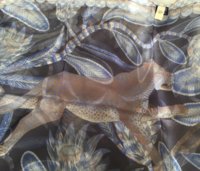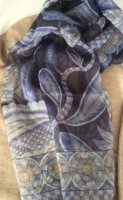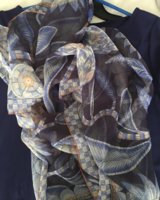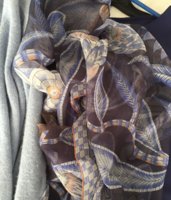Thanks very much for the explanation! That is super interesting.I love the pairing with that soft turquoise!
We are twins on this one— probably my all-time favorite mousseline, which is saying something, because mousselines are by far my favorite accessory!
The changeant effect is created by the weave rather than a particular pattern, so this is why you find some colorways of a pattern as changeants and others not. The changeant is created by crisscrossing different colored threads, which makes the colors appear to shift as the scarf ripples. If you look very closely at the scarf, you can see how it works, although it's more obvious in the silk twill changeants (which are uncommon, but do exist, as far as I know only in plain unpatterned scarves).
Some changeants are more subtle than others: I have a very obvious changeant that goes from emeraude to bordeaux, but I also have a very subtle changeant that transitions from rose poudre to jaune. The difference in drama is simply down to the fact that green and red are opposite on the color wheel, while soft pink and orangey-yellow are less polarized. Often H has indicated a changeant colorway with a double color name on the hang tag, but that's not a hard and fast rule. Combined with the changeant effect sometimes being subtler than others, this means occasionally changeant quality is debatable. But rest assured if a scarf is changeant, it's usually pretty easy to spot. The debatable ones are rare.
You are using an out of date browser. It may not display this or other websites correctly.
You should upgrade or use an alternative browser.
You should upgrade or use an alternative browser.
Scarves Chiffon (mousseline) scarves
- Thread starter Rockerchic
- Start date
TPF may earn a commission from merchant affiliate
links, including eBay, Amazon, and others
More options
Who Replied?Wow!! That is amazing information!! Thank you for sharing!!I love the pairing with that soft turquoise!
We are twins on this one— probably my all-time favorite mousseline, which is saying something, because mousselines are by far my favorite accessory!
The changeant effect is created by the weave rather than a particular pattern, so this is why you find some colorways of a pattern as changeants and others not. The changeant is created by crisscrossing different colored threads, which makes the colors appear to shift as the scarf ripples. If you look very closely at the scarf, you can see how it works, although it's more obvious in the silk twill changeants (which are uncommon, but do exist, as far as I know only in plain unpatterned scarves).
Some changeants are more subtle than others: I have a very obvious changeant that goes from emeraude to bordeaux, but I also have a very subtle changeant that transitions from rose poudre to jaune. The difference in drama is simply down to the fact that green and red are opposite on the color wheel, while soft pink and orangey-yellow are less polarized. Often H has indicated a changeant colorway with a double color name on the hang tag, but that's not a hard and fast rule. Combined with the changeant effect sometimes being subtler than others, this means occasionally changeant quality is debatable. But rest assured if a scarf is changeant, it's usually pretty easy to spot. The debatable ones are rare.

Hello my fellow moussie lovers!
I'm sidling up to the scarf confessional here again....
Moussies are my favorite format. And of those, I am particularly obsessed with changeants, which seem to be having a bit of an unspoken rest at the moment.
(I mean Jardin Anglais is an awesome scarf already, but can you imagine if some of them had been changeant????)
Anyway....I had some extra spending money after the holidays (yay- holidays?!? You make me over spend so much!) And despite having got not just one but 2 scarves under the tree and one of those a grail, I knew it had to be a scarf and so I wanted something special, and took my time deciding. Of course, my mind always drifts to changeant chiffon...so it took took weeks of searching but I finally found a new one for my little collection.
I'm so pleased to present Quadrige mousseline stole, in bleu gris/ardoise/mauve
which was colorway 08 from 2013. I gave it it's own little glamor shootto try and show the soft changeant effect of the greyish tone to lavender but this one is a lot more subtle than my La Rosee.
I haven't had a stole moussie before, and so now of course I am head over heels in love with the length, weight and ease of wear.
View attachment 3954847
View attachment 3954846
I like the dark blue horsey....
View attachment 3954844
'scuse the up close mod shot! It picked up the greyish to lavender change best....
View attachment 3954845
I'm really jealous f this one. I like the stoles too , so easy
Just adding a couple of illustrations for those who also find the mechanics of the changeant effect interesting.
First photo is of a silk twill changeant plisse. It's really easy to see how the weave works on this, and the "traveling color" effect is the same as on a mousseline changeant. The plisse, I would note, also has metallic threads, and I don't know whether that's true of mousseline changeants as well. The threads in mousselines are so fine that they could very well be metallic or slightly metallic and it wouldn't be obvious the way it is with a twill.
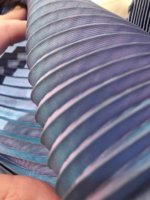
I also tried to photograph my Emeraude/Bordeaux Flots du Cheval close enough to show the weave on it, but all I seem to have succeeded in doing is making it look like it has lint on it! Clearly what is needed is someone in the field of Scarf Microscopy.
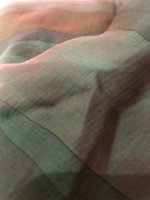

First photo is of a silk twill changeant plisse. It's really easy to see how the weave works on this, and the "traveling color" effect is the same as on a mousseline changeant. The plisse, I would note, also has metallic threads, and I don't know whether that's true of mousseline changeants as well. The threads in mousselines are so fine that they could very well be metallic or slightly metallic and it wouldn't be obvious the way it is with a twill.

I also tried to photograph my Emeraude/Bordeaux Flots du Cheval close enough to show the weave on it, but all I seem to have succeeded in doing is making it look like it has lint on it! Clearly what is needed is someone in the field of Scarf Microscopy.


Thank you Cakexandre on my APdP mousse, so happy to be your grail twin. I learned something new today reading your explanation on changeants. I only have one changeant thus far. Metallics seem not to suit my skin tones for some reason. I will try to photograph and share modeling photos this weekend.I love the pairing with that soft turquoise!
We are twins on this one— probably my all-time favorite mousseline, which is saying something, because mousselines are by far my favorite accessory!
The changeant effect is created by the weave rather than a particular pattern, so this is why you find some colorways of a pattern as changeants and others not. The changeant is created by crisscrossing different colored threads, which makes the colors appear to shift as the scarf ripples. If you look very closely at the scarf, you can see how it works, although it's more obvious in the silk twill changeants (which are uncommon, but do exist, as far as I know only in plain unpatterned scarves).
Some changeants are more subtle than others: I have a very obvious changeant that goes from emeraude to bordeaux, but I also have a very subtle changeant that transitions from rose poudre to jaune. The difference in drama is simply down to the fact that green and red are opposite on the color wheel, while soft pink and orangey-yellow are less polarized. Often H has indicated a changeant colorway with a double color name on the hang tag, but that's not a hard and fast rule. Combined with the changeant effect sometimes being subtler than others, this means occasionally changeant quality is debatable. But rest assured if a scarf is changeant, it's usually pretty easy to spot. The debatable ones are rare.

I'm really jealous f this one. I like the stoles too , so easy
Thank you pt!
Just adding a couple of illustrations for those who also find the mechanics of the changeant effect interesting.
First photo is of a silk twill changeant plisse. It's really easy to see how the weave works on this, and the "traveling color" effect is the same as on a mousseline changeant. The plisse, I would note, also has metallic threads, and I don't know whether that's true of mousseline changeants as well. The threads in mousselines are so fine that they could very well be metallic or slightly metallic and it wouldn't be obvious the way it is with a twill.
View attachment 3961960
I also tried to photograph my Emeraude/Bordeaux Flots du Cheval close enough to show the weave on it, but all I seem to have succeeded in doing is making it look like it has lint on it! Clearly what is needed is someone in the field of Scarf Microscopy.
View attachment 3961961
I think I can help you out there when the sun comes up....
Just adding a couple of illustrations for those who also find the mechanics of the changeant effect interesting.
First photo is of a silk twill changeant plisse. It's really easy to see how the weave works on this, and the "traveling color" effect is the same as on a mousseline changeant. The plisse, I would note, also has metallic threads, and I don't know whether that's true of mousseline changeants as well. The threads in mousselines are so fine that they could very well be metallic or slightly metallic and it wouldn't be obvious the way it is with a twill.
View attachment 3961960
I also tried to photograph my Emeraude/Bordeaux Flots du Cheval close enough to show the weave on it, but all I seem to have succeeded in doing is making it look like it has lint on it! Clearly what is needed is someone in the field of Scarf Microscopy.
View attachment 3961961
Here you go! Up close and personal changeant colors under 10x magnification. Chiffon is a loose open plain weave by nature of one over and one under threads (which is why you can see through it) but good quality threads have a tight spin on them which also makes them strong, so even though they are see through, they are often fairly hardy (within reason).

Bunnycat, I am in awe that you really have gotten us a microscopic view!!! Super cool! So glad your changeant was ready for her ultra-closeup.
Here you go! Up close and personal changeant colors under 10x magnification. Chiffon is a loose open plain weave by nature of one over and one under threads (which is why you can see through it) but good quality threads have a tight spin on them which also makes them strong, so even though they are see through, they are often fairly hardy (within reason).
View attachment 3962196
Bunnycat, I am in awe that you really have gotten us a microscopic view!!! Super cool! So glad your changeant was ready for her ultra-closeup.
An unorthodox use of a jewelers loupe!

I love the pairing with that soft turquoise!
We are twins on this one— probably my all-time favorite mousseline, which is saying something, because mousselines are by far my favorite accessory!
The changeant effect is created by the weave rather than a particular pattern, so this is why you find some colorways of a pattern as changeants and others not. The changeant is created by crisscrossing different colored threads, which makes the colors appear to shift as the scarf ripples. If you look very closely at the scarf, you can see how it works, although it's more obvious in the silk twill changeants (which are uncommon, but do exist, as far as I know only in plain unpatterned scarves).
Some changeants are more subtle than others: I have a very obvious changeant that goes from emeraude to bordeaux, but I also have a very subtle changeant that transitions from rose poudre to jaune. The difference in drama is simply down to the fact that green and red are opposite on the color wheel, while soft pink and orangey-yellow are less polarized. Often H has indicated a changeant colorway with a double color name on the hang tag, but that's not a hard and fast rule. Combined with the changeant effect sometimes being subtler than others, this means occasionally changeant quality is debatable. But rest assured if a scarf is changeant, it's usually pretty easy to spot. The debatable ones are rare.
@calexandre - thank you so much for this explanation! The changeants are so beautiful!Just adding a couple of illustrations for those who also find the mechanics of the changeant effect interesting.
First photo is of a silk twill changeant plisse. It's really easy to see how the weave works on this, and the "traveling color" effect is the same as on a mousseline changeant. The plisse, I would note, also has metallic threads, and I don't know whether that's true of mousseline changeants as well. The threads in mousselines are so fine that they could very well be metallic or slightly metallic and it wouldn't be obvious the way it is with a twill.
View attachment 3961960
I also tried to photograph my Emeraude/Bordeaux Flots du Cheval close enough to show the weave on it, but all I seem to have succeeded in doing is making it look like it has lint on it! Clearly what is needed is someone in the field of Scarf Microscopy.
View attachment 3961961
(Of course the plain ole moussies are too!)
ahaahaha - bunnycat - you are awesome! Thank you!Here you go! Up close and personal changeant colors under 10x magnification. Chiffon is a loose open plain weave by nature of one over and one under threads (which is why you can see through it) but good quality threads have a tight spin on them which also makes them strong, so even though they are see through, they are often fairly hardy (within reason).
View attachment 3962196
Scarf mail!! The Savana dance 08 marine/ciel/camel mousseline stole
This will be such an easy one for me- goes with navy, camel, lots of shades of blue...View attachment 3962682 View attachment 3962683 View attachment 3962684 View attachment 3962685 View attachment 3962686 View attachment 3962687
It’s beautiful! Congratulations!
Scarf mail!! The Savana dance 08 marine/ciel/camel mousseline stole
This will be such an easy one for me- goes with navy, camel, lots of shades of blue...View attachment 3962682 View attachment 3962683 View attachment 3962684 View attachment 3962685 View attachment 3962686 View attachment 3962687
Beautiful scarf1! All those blues are heavenly!
It’s beautiful! Congratulations!
Beautiful scarf1! All those blues are heavenly!
Thanks!So pretty and so you, Scarf1!
Register on TPF! This sidebar then disappears and there are less ads!



